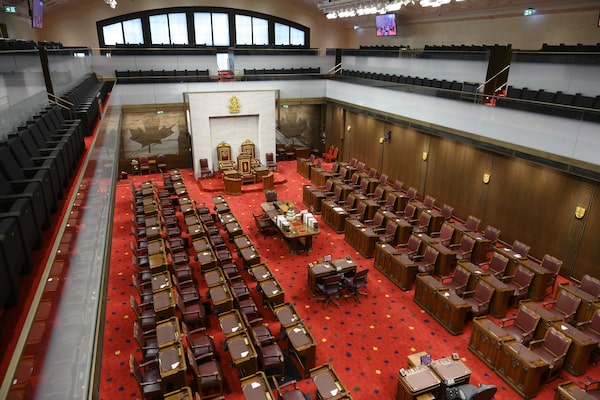
The Senate of Canada building and Senate Chamber in Ottawa on Feb. 18, 2019.Sean Kilpatrick/The Canadian Press
Ten years ago, when the Senate was embroiled in a gaudy expenses scandal and then-prime minister Stephen Harper was refusing to name any new senators until the unelected half of Parliament cleaned up its act, many Canadians probably wondered what the future held for an institution that seemed outdated and was in need of reform.
Ten years later, we have the outlines of an answer. The Senate is more expensive than ever and, as we learned this month, just as partisan.
Last week, the CBC reported that eight out of the last 12 senators appointed by Prime Minister Justin Trudeau were Liberal Party donors, or had worked with the federal Liberal Party or a provincial Liberal party.
This contradicts Mr. Trudeau’s claim that his goal for the past eight years has been to create a “non-partisan” Senate, composed “merely of thoughtful individuals representing the varied values, perspectives and identities of this great country.”
In 2014, while still just Liberal Leader, he kicked every Liberal senator out of his caucus and said they would sit as independents. In 2016, when he was Prime Minister, his government created a non-partisan body that takes applications from Senate aspirants and sends him a list of potential appointees.
While it was always better for the health of the skeptical mind to put the words “independent senator” in quotation marks when it came to the political persuasions of Mr. Trudeau’s 82 appointments since 2016, the tenor of his latest ones makes it a medical necessity.
His new appointments also happen to come in the wake of a reform of Senate rules pushed through by the government in May that gives the 73 Trudeau-named senators who are currently sitting the same powers to defer votes and filibuster as those of their Conservative colleagues. This is Mr. Trudeau’s Senate now, in spite of any claims he makes to the contrary.
On the expense front, in the past decade the Senate’s annual costs have risen dramatically. Its expenditures in 2014-15 were $85.4-million; its estimated expenditures for 2024-25 are $134.9-million. That’s a 58-per-cent increase over a decade for a body that has not grown in size. How could it, since there are only 105 Senate seats.
Except that it has indeed grown. This space previously noted that the Senate had the equivalent of 372 full-time employees in 2017. As of last year, it had 493 – a 32.5-per-cent jump.
What cost taxpayers $813,356 a senator per year a decade ago now costs $1.3-million. Given that there are usually about 10 vacancies in the Senate at a given moment (that’s how many there are at the time of writing this), that figure is more like $1.4-million.
Are Canadians getting more for their money in the Trudeau Senate? It’s not clear.
The Senate is a critical part of our parliamentary system. Its members review bills from the House of Commons and propose useful amendments, thereby serving as a pause-for-thought button on government legislation.
But an analysis by The Globe and Mail found that, from November, 2021, to March, 2023, an average of about 25 senators were absent for legislative votes, and that many of those who skipped the most votes were appointed by Mr. Trudeau.
The Senate’s committees hold hearings on pressing matters and, over the course of each Parliament, produce dozens of what the Library of Parliament categorizes as “substantive reports” on a wide array of issues (as opposed to legislative reports or administrative reports related to committee finances).
Strangely, the number of substantive reports produced by Senate committees has dropped notably since Mr. Trudeau began flooding the chamber with his appointments, based on records available on the Parliament of Canada website.
In his first term, from 2015 to 2019, the Senate produced 152 substantive reports, an average of 3.3 a month over the life of the 42nd Parliament. In the current Parliament (the 44th), the Senate has produced just 43 substantive reports to date – an average of 1.3 a month.
The difference is stark enough to merit attention. What it implies is that, on top of being more expensive but no less partisan than it was before, the Senate is also now less productive. That’s not something anyone would have predicted a decade ago.
Editor’s Note: This article has been updated to clarify the types of Senate reports categorized as “substantive reports” by the Library of Parliament.